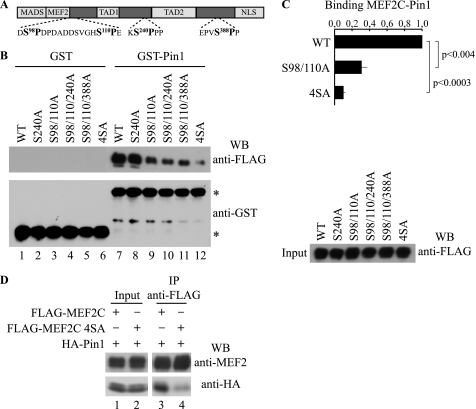FIGURE 5.
Phosphorylated Ser98, Ser110, Ser240, and Ser388 of MEF2C are required for the interaction with Pin1. A, representation of MEF2C together with the putative Pin1 consensus motifs (boldface type). B, different Ser-Ala point mutants of FLAG MEF2C were assayed for interaction with GST (lanes 1–6) and GST Pin1 (lanes 7–12) upon overexpression in COS1 cells followed by Western blot (WB) with anti-FLAG antibody (top) and anti-GST antibody (bottom); the positions of the GST and GST-Pin proteins are indicated with asterisks. The FLAG-tagged MEF2C protein inputs were also checked by anti-FLAG Western blot shown to the right. C, quantification of the ability of the MEF2C mutants to interact with Pin1. The intensities of the signals shown in B were quantified by densitometric scanning; in the histogram they are expressed relative to the value obtained with FLAG-MEF2C wild type (WT), which was assigned a value of 1 (mean ± S.D. (error bars) of three independent experiments). D, co-immunoprecipitation. COS1 cells expressing FLAG-MEF2C (lanes 1 and 3) or FLAG-MEF2C 4SA (lanes 2 and 4) in association with HA-Pin1 were cross-linked with DSP, the proteins were extracted, and the lysates were subjected to immunoprecipitation (IP) with anti-FLAG antibody and Western blotted for anti-MEF2 (top) or anti-HA (bottom); FLAG-tagged and HA-tagged protein inputs were also checked (lanes 1 and 2).

